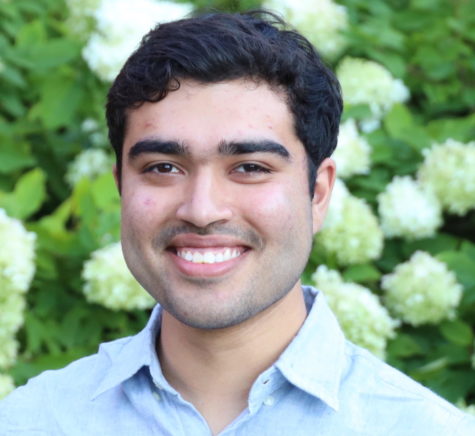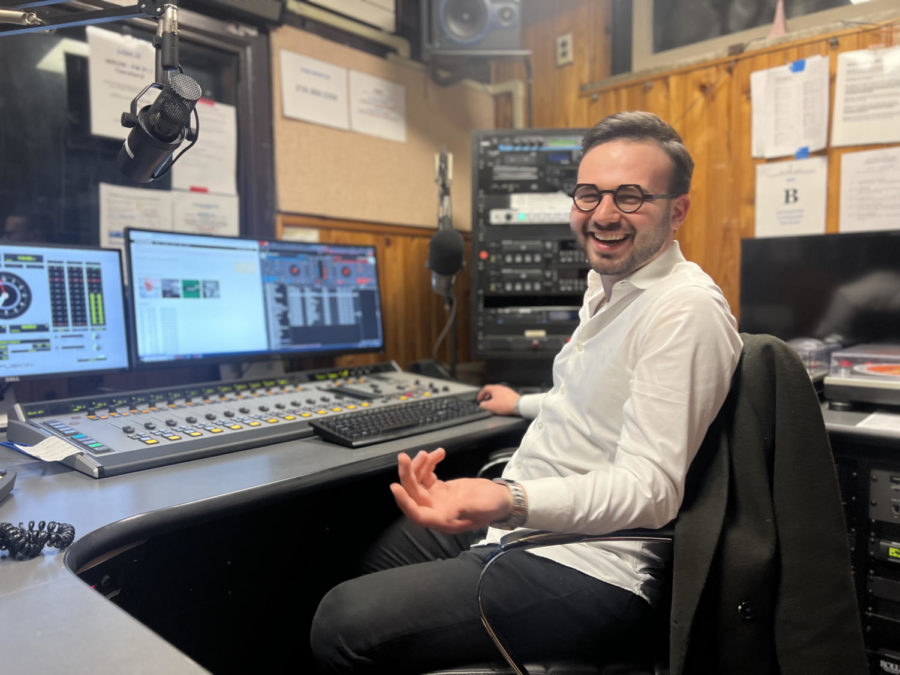The man in the radio booth
Talking art, jazz and fashion with a WRUW host
Have you seen this man on campus? He’s DavidPatrick Ryan, host of the WRUW show “Jazz Night in Cleveland,” reclining in his studio where he introduces famous and unknown jazz artists alike.
“Tune in to WRUW for an absurdly eclectic mix of music. From roots music to metal. From polka to neo-classical onwards. From jazz to indie and alternative rock, and other sounds I still can’t quite identify. WRUW FM 91.1 Cleveland. More music, fewer hits.”
With this on-air promo, WRUW introduces itself not just as the college radio station of Case Western Reserve University, but as a gateway to worlds of music that you might not even realize exist. With shows that feature music ranging from vapor wave to folk, you are guaranteed to find a song playing on WRUW that you wouldn’t on any other station on your radio dial. Though radio is no longer the preferred medium of music listening for those currently attending CWRU, our university still has a vibrant radio scene, with students managing the operations of WRUW and many of the shows featured within.
To broadcast such an array of “eclectic” music requires a mix of eclectic students. It requires students who are, first, willing to have their own radio show, but also willing to show off their own sufficiently diverse taste in music. So what kind of CWRU student would host their own WRUW show and share their music with the world?
Fortunately for me, I know just the sort of person. DavidPatrick Ryan is a fourth-year art history and history double major at CWRU and currently hosts the show “Jazz Night in Cleveland” on Tuesday nights from 8-9 p.m. I first met DavidPatrick in fall 2019, during what was both of our first semesters at CWRU. I distinctly remember seeing him walking on Mather Quad, wearing a fedora, a long overcoat and a messenger bag. With his unique apparel, cleanly shaped beard and round-rimmed glasses, I thought he was a professor. It wasn’t until he sat down in one of my classes that I realized that he was a student. This is a fairly common occurrence around CWRU campus, with “DPR sightings,” as they are known, driving conversations at times. Sitting down with him, I was very curious to see how he felt about his own notoriety.
“I don’t think I resent it. I think I enjoy it, and I find it a little weird at the same time,” Ryan responded. “It’s amusing when everyone knows who you are, but you’ve never met before. It’s also really friggin’ weird, because you’re worried like, ‘Are people talking bad? Do people find this like obnoxious or pretentious?’ At the same time, I think I’m just also very dedicated to doing things … the way that I see fit to myself.”
As he was sitting in front of me, he was wearing a white button-down shirt with the top two buttons undone, black skinny jeans, black monk strap dress shoes and a black woolen trench coat—which is on the lighter end of DPR outfits. Describing his outfits as being akin to “an art project,” he also noted that some aspects of his wardrobe had symbolic value to himself.
“A lot of jazz musicians have worn fedoras. I used to watch a lot of old cinema in high school; they’re always wearing fedoras. So just these things that kind of got built into my personality, because … that old cinema culture, and the jazz culture, are associated with nice hats. And that’s kind of a thing that I kind of carry on.”
The fedora omnipresent on his head was the namesake for one of his previous WRUW shows, “The Felt Fedora,” which he ran in fall 2021 to showcase mellow songs from the Great American Songbook of 20th century jazz standards. All of his shows, which he has consistently run since fall 2020, have had some connection to jazz, owing to his deep connection with the musical genre.
Though he is an art history and history double major, his academic interests are rooted in jazz, especially the communities of African American musicians who moved abroad through the 1920s and 1960s and spread jazz throughout the globe.
“For art history, I’m looking at the way race plays in depictions of modern art images of jazz. So yeah, it seeps into everything. Nothing is safe from the jazz bug.”
He started by listening to the famous crooner Tony Bennett through his duet albums with Lady Gaga, which then spurred Ryan to see Bennett live in Cleveland around his 14th birthday. Afterwards, he was hooked and started going to jazz shows around the Cleveland area with his high school classmates, including at venues such as the now-closed Waterbury Coach House, the under-renovation Nighttown and the Bop Stop, which is still open.
“There’s nothing more entertaining than live music,” Ryan remarked. “But people don’t realize that they listen to recorded music, go to parties with recorded music and don’t have as many interactions with live music anymore, which I find to be the most entertaining, social thing you can do.”
By going to live shows in Cleveland, Ryan was able to develop relationships with various jazz artists from the Cleveland area, including vocalist Doris Long, whom he interviewed and later conversed with. Long recently passed away at the age of 94 and, in tribute to her, Ryan dedicated the last 15 minutes of his program on Jan. 24 to her renditions of jazz standards. Since the pandemic, several jazz venues in Cleveland and Akron have shut down, making going to live performances tougher for new and old jazz listeners alike.
“[Jazz in Cleveland] is at best in a transition period,” Ryan said. “It’s very hard to sustain an entire Cleveland [jazz] scene around the Bop Stop … Now what you’re seeing is a lot of places like … bars, restaurants, whatever, having a one night a week jazz program. And that’s how musicians are probably sustaining themselves…Jazz is hard, because it’s becoming something where it’s not really like a young man’s game or young woman’s game…You really have to be into the music now.”
While Ryan’s dream is to one day open a jazz club of his own, for now he is content with his radio show as a means to spread awareness of jazz.
Having listened to the radio as a result of having an older car that did not have a Bluetooth or AUX option, Ryan found value in it despite admitting that “commercial radio is terrible at this point.” In a time where we have unlimited access to music choices, that choice can be overwhelming. In Ryan’s view, radio can be an avenue to more focused listening, where hosts can curate music and allow people to explore new songs that they didn’t even know were out there, rather than listening to the same playlists over and over as we do on streaming services.
“I just kind of try to play a wide variety of jazz from everything that is very traditional, very well known, to something that’s very uncomfortable and dissonant because all of it should have some airtime. And I think eventually it would be great to get to a point where I could dedicate a whole program to one style or another. But for now, what I do is try to present a wide variety of interests within jazz.”
In the WRUW studio, which is plastered with all sorts of retro stickers and filled to the brim with new and old CDs and vinyls, Ryan beams with excitement as he shows me all the different aspects of his setup.
“I especially love bringing people down [to the studio] actually, because everyone’s amazed for the first 15 minutes. Then after that, they’re like, ‘Oh, wait, there’s nothing I can do or touch. This is kind of boring.’ But I like bringing people down.”
As he prepares for the night’s set, he pulls up all the requisite advertisements and promos that’ll go before he starts, along with the actual songs for the program. Starting with John Coltrane’s “Blue Train,” continuing with newer jazz such as Snarky Puppy’s “Portal,” returning to standards by Frank Sinatra and Tony Bennett and finally concluding with a series of Doris Long songs, Ryan is able to put together a diverse one-hour program. While most of his listeners, he admits, are not from CWRU but are primarily older Clevelanders, he doesn’t mind.
“We do a service for Cleveland that is constant, as in 24/7, 365, and really impacts a very large, broad range of the Cleveland population,” Ryan says. “[WRUW is] an institution that is not seeking money from the radio station. And it gives space for there to be experimental music, for music that is no longer played or is not yet played.
“As much as I’d like to do something noble, keeping something that’s very beautiful alive in some very small way, I don’t know how necessary that is. Because jazz has become a musician’s game; musicians love jazz, and they have maintained a community. It’ll probably always exist, the way that there will always be a classical music community. It just might seem declined, because it’s not as popular as it was in the ‘60s or earlier … It’ll probably always survive.”
As the promos begin to end and the time to start the set approaches, Ryan stands up from his chair, puts on his headphones, leans into the microphone and says, “Hello, and welcome back to Jazz Night on WRUW FM 91.1 Cleveland.” And just like that, the show begins.

Shreyas (he/him) is a fourth-year student majoring in biology and philosophy. If he isn't yammering to you about how great "Pet Sounds" is or making bad...


